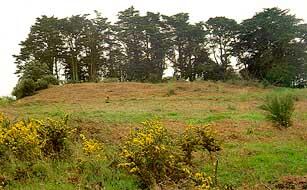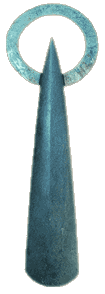- Home
- Megalithism in Morbihan
- Locmariaquer
- From Mané-Lud to Mané-er-Hroeg
- Introduction
- Carnac
- Gavrinis
-
Locmariaquer
- The peninsula and its monuments
- A cradle of archeological research
- Before the megaliths
- Grand-Menhir (Great Menhir)
- Er-Grah Tumulus
- La Table-des-Marchands (Merchants’s table)
- From Mané-Lud to Mané-er-Hroeg
- Pierres-plates (Flat Stones), a late tomb
- Megalithic art in Locmariaquer
- Locmariaquer, from Antiquity to the Middle Ages
- Le Petit-Mont
- Architectural types
These are two other major monuments in the megalithic Heritage at Locmariaquer. Their excavation, in 1863-64 by the Société polymathique du Morbihan (the Morbihan archaeological society), is an important event in the history of French archaeology.
"High Hill " or "Ash Mount"?
The Mané-Lud mound is the first large monument at Locmariaquer that can be seen when coming from Auray. Located on what is almost the highest point in the peninsula, this is the only monument whose name was passed on to us by De Robien, under its French 18th century form Mont-Helleu. This can be related to the Breton term Uhelan ("higher up") but certainly not to "ashes" ludu (human ones of course!) as some morbid minds suggested.
It is a large "carnacean barrow" 80m long, 50m wide and 5m high. In the centre, a round cairn hid a stone-built burial chamber, 2.25x1.25m, covered with corbelling. It revealed the remains of two persons with only a few flints and pottery sherds.
The central cairn was extended eastwards by a heap of stones bordered by a strange structure:
- every 2m, six large standing stones formed a slightly concave westerly facing arc,
- supporting bones identified as horse skulls.
All this lay under a 4m thick layer of "mud" which made up most of the tumulus.
The western end of the monument projects among the houses in the village. A large passage grave is inserted in a second cairn, with outwardly visible stones. It is partly covered by a huge orthogneiss slab (8.3m long, 4m de wide and 0.5m deep), which was probably broken by a cantilever and has lost its end.
The chamber has been open from time immemorial (it was used as a stable) and its passage has been cut by adjoining buildings. The structure is strictly megalithic, with contiguous slabs (sometimes overlapping to provide a watertight cover). The floor of the chamber is made up of a single, large, ogival-shaped orthogneiss slab, probably a re-used anthropomorphous stele.
Several ornate uprights line in the chamber and the passage.
The Mané-Lud mound
Plan of the western Mané-Lud dolmen. The large shield-slab makes up the floor of the chamber and give it its shape. The ornate uprights are in grey.
Mané-er-Hroeg and its satellite menhirs
This 100x60m oval mound is made up of 20,000m3 of stones. Surrounded by buildings and covered with scrub, it unfortunately lost some of its monumental features.
Archaeologists in the last century dug a crater from the top and found a 4x3m central burial chamber, roughly stone-built and covered with two orthogneiss contiguous blocks (an old menhir cut in two?).
The chamber had been closed again to the North from the outside with rough battening, in which fragments of a richly decorated stele were found.
A number of exceptional artefacts were found in the chamber (now in the Vannes Museum):
- a large jadeite ring-disc, two beautiful jadeite axe heads and several variscite pendants were found on the paving slab;
- below the slab, 11 broken jadeite axes (one of them 47cm long) and 90 fibrolite axes lay next to 44 beads and 5 variscite drops, two polished hatchets and one arrowhead.
Two long orthogneiss blocks lie next to each other at the West end of this princely mausoleum. A menhir used to stand nearby but it has been moved to an estate in the vicinity.
The two large orthogneiss blocks lying in front of Mané-er-Hroeg, from a postcard dated early 20th century.
The large prestige axe and the jadeite ring-disc which lay on the slabbing in the centre of the Mané-er-Hroeg chamber.



